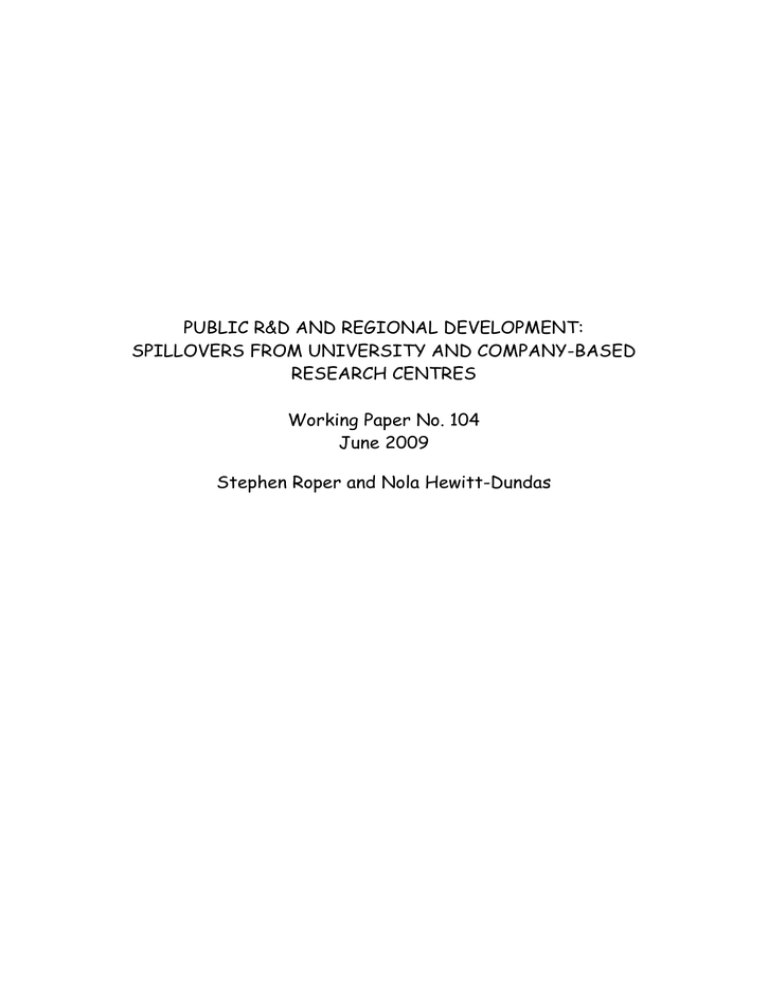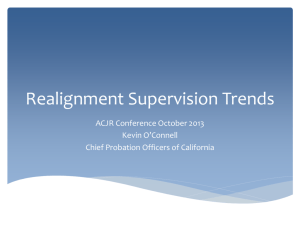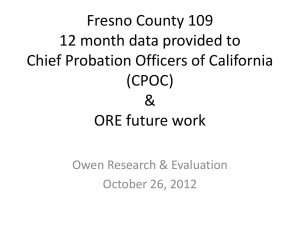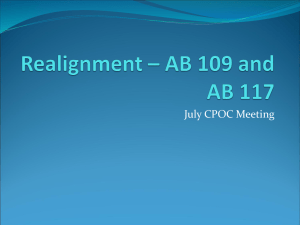PUBLIC R&D AND REGIONAL DEVELOPMENT: SPILLOVERS FROM UNIVERSITY AND COMPANY-BASED RESEARCH CENTRES
advertisement

PUBLIC R&D AND REGIONAL DEVELOPMENT: SPILLOVERS FROM UNIVERSITY AND COMPANY-BASED RESEARCH CENTRES Working Paper No. 104 June 2009 Stephen Roper and Nola Hewitt-Dundas Warwick Business School’s Small and Medium Sized Enterprise Centre Working Papers are produced in order to make available to a wider public, research results obtained by its research staff. The Director of the CSME, Professor Stephen Roper, is the Editor of the Series. Any enquiries concerning the research undertaken within the Centre should be addressed to: The Director CSME Warwick Business School University of Warwick Coventry CV4 7AL e-mail stephen.roper@wbs.ac.uk Tel. 02476 522501 ISSN 0964-9328 – CSME WORKING PAPERS Details of papers in this series may be requested from: The Publications Secretary CSME Warwick Business School, University of Warwick, Coventry CV4 7AL e-mail sharon.west@wbs.ac.uk Tel. 02476 523692 1 Public R&D and Regional Development: Spillovers from University and Company-based Research Centres Stephen Ropera and Nola Hewitt-Dundasb a Centre for Small and Medium Enterprises, Warwick Business School, University of Warwick, Coventry, CV4 7AL, Email: Stephen.Roper@wbs.ac.uk b School of Management, Queen‘s University Belfast, BT7 1NN Email: nm.hewitt@qub.ac.uk Abstract: Public funding of university and company-based R&D centres of excellence is widespread both in core and more peripheral regions in the hope of generating local knowledge spillovers. In this paper we examine one such initiative involving the establishment of 18 publicly funded R&D centres. Based on data from a real-time monitoring study, we explore the development of the centres‘ external connections. University-based centres are found to develop more extensive local and extra-regional connections than company-based centres, with company-based centres most willing to form new local connections where their partner is either a customer or supplier. Our results suggest a generally positive message, emphasising the potential for public R&D investments to generate increased local and extra-regional connectivity. They also suggest a prioritisation among such investments, however, in order to derive the maximum benefit for regional economic development. Acknowledgements: We are grateful to Invest Northern Ireland for funding the research on which this paper is based. We also wish to express our thanks to Beth Young for providing excellent research assistance and to the staff in the Centres of Excellence for providing time and assistance in undertaking this study. Valuable comments were received from James Love (Aston Business School). Interpretations and mistakes in the paper are those of the authors alone. Key words: Public R&D, regional development, knowledge transfer, Northern Ireland. 2 PUBLIC R&D AND REGIONAL DEVELOPMENT: SPILLOVERS FROM UNIVERSITY AND COMPANY-BASED RESEARCH CENTRES 1. Introduction Recent thinking on open innovation (Chesbrough, 2003; Chesbrough et al 2006), buiness eco-systems (Iansiti and Levien, 2004), and the knowledge-based economy (Cooke and Leydesdorff, 2006) has stressed the importance of external knowledge sources in stimulating innovation. Empirical studies at the firm-level, provide confirmatory results, emphasising the role of knowledge networks and partnerships in shaping firms‘ innovation activity (Veugelers and Cassiman, 1999; Cassiman and Veugelers, 2002; Love and Roper, 2001, Tether, 2005). From a policy-perspective, one attempt to foster greater interaction between innovation actors has been through the establishment of publicly funded research centres (PRCs) with the objective of stimulating science-industry links and localised knowledge spillovers (Debackere and Veugelers, 2005). For example, in the US, Feller (2004) demonstrates the importance of public research universities to economic development, while in the EU, Graversen et al. (2005) have examined the role of Centres of Excellence in achieving EU objectives relating to the European Research Area1. Recent evidence, however, suggests that the producitivity benefits from PRCs engaging in different types of knowledge transfer activity, and operating in different organisational contexts, may differ significantly (Graversen et al., 2005). BilbaoOsorio and Rodriguez-Pose (2004), for example, analyse the impact of different forms of R&D expenditure on innovation (measured as patent applications per capita) across EU regions. They find that while business expenditure on R&D (BERD) is the sole driver of innovation in non-peripheral regions, in peripheral regions, both BERD and higher-education expenditure on R&D (HERD), but not other public R&D, has a positive effect on innovation. They speculate that the reason for this may be that university research has a more applied (rather than basic) orientation in peripheral areas, compensating for a lack of BERD (Fernandez et al., 1996). At a more general 1 Feller (2004) also focuses on the need for universities to maintain a high quality and well resourced research environment to attract and retain high quality research staff, with the result that ‗states which are either unable or unwilling to provide the financial support necessary to maintain competitive higher education systems are likely to fall behind in longer term efforts to develop nationally competitive knowledge-based economies‘ (p.141). 3 level, recent research by Guellec and van Pottelsberghe (2004) based on 16 OECD countries, also emphasises the differential returns from different types of R&D activity2. Other studies, while stressing the strong spillover benefits of university research (Anselin et al. 1997, 2000; Fischer and Varga, 2003; Verspagen, 1999) also stress the differential strength of such spillovers from R&D in different sectors/disciplines as well as the localised nature of such effects (Audretsch, 1998). For example, evidence of localised knowledge spillovers suggested by pharmaceuticals firms‘ location of their R&D facilities near to leading university research departments. By contrast, for firms in the chemicals or vehicles sectors, such co-location is less evident (Abramovsky and Simpson, 2008). The absorptive capacity of local firms may also influence the effective contribution of knowledge spillovers to economic growth3. Guellec and van Pottelsberghe (2004), for example, stress the role of BERD in shaping firms‘ absorptive capacity, while Veugelers and Cassiman (1999) suggest that firms undertaking in-house R&D benefit more from external information sources than firms which have no in-house R&D activity (Roper et al., 2000; Hewitt-Dundas, 2009). An essentially similar point is made by Oughton et al. (2002) who consider what they call the ‗regional innovation paradox‘, which they define as ‗the apparent contradiction between the comparatively greater need for firms to invest in innovation in lagging regions and their relatively lower capacity to absorb public funds earmarked for the promotion of innovation‘ (p.98). Our objective here is to examine the new connectivity that arises from PRCs and whether these are influenced by the organisational context in which the PRC is operating, i.e. whether the PRC is university or company based. Our study is based on 2 Specifically, they found a long-term elasticity of multi-factor productivity (MFP) with respect to BERD of 0.13, foreign R&D of 0.45 and public R&D of 0.17. However, Lichtenberg and Siegel (1991) also observed a strong positive correlation between privately funded R&D and TFP growth; however this was not the case for publicly funded R&D. This was confirmed by Billings et al. (2004), who found that publicly funded R&D is significantly less productive than privately funded R&D. 3 Zahra and George (2002) provide a comprehensive review of organisational applications of the concept of ACAP to innovation (Cohen and Levinthal, 1990; Veugelers, 1997), best practice (Szulanski, 1996), research productivity (Cockburn and Henderson, 1998), and IT adoption (Boynton, Zmud and Jacobs, 1994). 4 a real-time monitoring exercise of the developing patterns of connectivity in a group of UK PRCs established since 2002. This localised, and more detailed approach, complements the more abstract but broadly based analysis of Guellec and van Pottelsberghe (2004), providing insights into the mechanisms by which local knowledge transfers actually occur, and how these are constrained or enabled by PRCs‘ organisational context. Our paper also helps to answer the need highlighted in Link and Siegel (2005a) for more specific micro-evidence on the operation of technology transfer initiatives in different national and regional contexts. The remainder of the paper is organised as follows. Section 2 outlines the conceptual approach and hypotheses, drawing on Boyne (2002) and focussing on the contrasting organisational contexts of company-based and university-based PRCs. Section 3 reviews the policy context for the empirical study and profiles the group of PRCs considered in our study. Section 4 reports our main empirical results and Section 5 draws out the key methodological and policy conclusions. 2. Literature and Hypotheses In this section we consider the distinctive characteristics of public and private sector organisations and the implications for the profile of external connections that might develop from university-based and company-based PRCs. Boyne (2002), for example, suggests that despite some tendency towards convergence, contrasts between public and private sector organisations generally exist along four dimensions: organisational environment, goals, structures and values. In terms of organisational environment, Boyne argues that public sector organisations face: more diverse stakeholders than private sector organisations generating potential goal ambiguity (see also Jarzabkowski, 2005); greater pressures to be responsive to a range of stakeholder needs perhaps contributing to greater instability; and, less competitive pressure than that facing private sector organisations. These contrasts are clearly reflected in the contrasting environments of universitybased and company-based PRCs. University-based PRCs may face conflicting 5 expectations of their potential cultural, social and economic contribution4, while for company-based PRCs shareholders represent the primary interest group with the more focussed goal of sustained competitiveness. This less diverse stakeholder group and firms‘ more focused organisational goals are likely to be associated with a more reluctant approach to knowledge sharing to ensure that proprietary knowledge is protected (Bozeman, 2000)5. University-based PRCs on the other hand, may be characterised by more openness to their associated stakeholder communities motivated by an ethos of ‗open science‘ (European Commission, 2004). We therefore anticipate ceteris paribus that: Proposition 1: Connectivity: University-based PRCs will establish a greater number of new external connections than company-based PRCs. Although the organisational environment of universities and companies vary markedly, it is likely that in a PRC, with an emphasis on knowledge generation, the commonality between university-based and company-based PRCs may be greater. PRCs‘ external connections can play two distinct roles. First, they may be an intrinsic part of the knowledge generation process enabling knowledge co-creation. Second, they may be part of PRCs knowledge exploitation or value added generating activities, reflecting the contribution of research outputs to innovation (Katz and Martin, 1997; David et al 1988). According to Rothwell (1994, p.22), for example, innovation involves ‗horizontal linkages such as collaborative pre-competitive research, joint R&D ventures and R&D-based strategic alliances, i.e. innovation is becoming more of a networking process‘. Rothwell refers to this model of innovation as ‗systems integration and networking‘, while Chesbrough (2003) terms it ‗open innovation‘, with external knowledge seen as important in reducing development time, and reducing the risk and cost of development6. 4 For example, the UK 2003 Higher Education White Paper (The Future of Higher Education, DfES, 2003) emphasised that ‗Universities and colleges are key drivers … both economically and in terms of the social and cultural contribution they make‘. 5 For example, Dunning (1993) in examining the knowledge transfer activities of multinational enterprises comments that deliberate knowledge transfers will only occur where plants perceive there to be a direct benefit: i.e. ‗Where the improvement of local supply capability is critical to the competitiveness of the purchasing company... then it may pay the company to invest resources in upgrading the efficiency of its suppliers‘ Dunning (1993, p.456). 6 This approach stands in stark contrast to the ‗closed innovation‘ model whereby organisations depend solely on in-house R&D with very limited inter-organisational knowledge sharing. 6 For both company-based and university-based PRCs knowledge co-production with other organisations as part of their R&D or knowledge generation activities are therefore likely to be important. For university-based PRCs, however, external connectivity is likely to be more important as part of their innovation or exploitation activities than for company-based PRCs reflecting the diversity of stakeholder interests in university-based PRCs and the open science ethos7. This leads to our second proposition relating to the diversity of PRC‘s external partners: Proposition 2: Linkages Pattern – University-based PRCs will engage with a broader range of external partners than company-based PRCs. With significant public sector investment in the PRCs, it is important to understand not only the extent of external links which create the potential for knowledge spillovers, and the range of external actors with which this activity occurs, but also their spatial distribution. Research on the role of proximity in the transfer of knowledge suggests that in general terms ‗agents that are spatially concentrated benefit from knowledge externalities. Short distances literally bring people together, favour information contacts and facilitate the exchange of tacit (implicit/unable to codify) knowledge‘ (Boschma, 2005, p.69). Other research, however, suggests that as cognitive proximity – the common expertise and knowledge base - increases the importance of physical proximity may decrease (Hewitt-Dundas, 2009). For firms, competitive pressures may lead to hollowing-out and a focus on core-competencies limiting cognitive proximity and emphasising physical co-location, an influence which will be reinforced by the geographical concentration of supply chains. Market pressures are likely to be less important for universities, allowing a broader cognitive base to be maintained and the potential for greater cognitive proximity with external partners. This suggests our third proposition: 7 It is also possible that in some instances Universities may have a financial motive in forming external links which may result in them focusing on specific industrial partners, particularly where research is applied and commercial technologies may result (Link and Scott, 2005). In such a situation, the potential number of external partners may be restricted. 7 Proposition 3: Knowledge Profile – Company-based PRCs‘ external connections will be more locally concentrated than those of university-based PRCs. 3. Programme Overview The research centres considered here were established with support from Northern Ireland (NI) government in 2002 as part of the Centres of Excellence programme, and with the objective of contributing to regional competitiveness8. A total of eighteen research centres (eight university and ten company-based PRCs) were established as a result of two competitive calls for proposals during 2002 (Table 1). Managed by Invest NI – the Regional Development Agency (RDA) for Northern Ireland – the Centres received public funding of £34.7m (30.0 per cent) matched by an additional £79.7m from the Centres‘ host organisations over a three-year funding period. Figure 1 illustrates the trend in centre employment and expenditure with total employment peaking in early 2005 at the end of the grant supported period. The ten company-based PRCs accounted for 40.3 per cent of total expenditure and received 32.0 per cent of grant aid. The eight university centres on the other hand received 68.0 per cent of programme funding and made up 59.7 per cent of total spending. The difference between the breakdown of the number of centres and that of expenditure and grant support is due to the larger average size of the university centres (£8.5m compared to £4.6m) and the higher level of grant support they received (50 per cent as opposed to the 20-25 per cent received by the company-based PRCs). The significance of the programme for Northern Ireland is suggested by the fact that the establishment of the university-based PRCs increased higher education R&D by around a fifth and the company-based PRCs added around a tenth to business R&D in the region (Source: DETI, 2005). As a result of the competitive and reactive nature of the support programme the PRC‘s sectoral coverage was diverse and unrepresentative of all business R&D in Northern Ireland. For example, service-sector R&D is under-represented in the programme with only one service sector PRC accounting for 11.3 per cent of 8 Specifically: ‗The RTD Centres of Excellence programme supports the establishment of R&D centres to stimulate leading edge, industrially exploitable and commercially focused research which will demonstrably improve the competitiveness of Northern Ireland industry,‘ (Invest NI, 2003). 8 programme spend, compared to 24 per of regional business R&D in 2002 (Table 1)9. In terms of manufacturing, pharmaceuticals was over-represented in the programme, accounting for around 12.3 per cent of manufacturing BERD in the region in 2002 but around a third of programme expenditure10. In relation to the type of R&D being undertaken in the PRCs, and therefore having the potential to be transferred to other organisations, each PRC was undertaking a range of different research activities spanning the normal basic, applied and developmental distinction (Table 1)11. Organisationally, differences were also evident in the strategic role of the PRCs within their host companies and universities. For example, university-based PRC.5, sits alongside an internationally recognised centre for basic research in environmental technologies with the aim of developing new commercially-relevant, environmental ‗tools‘ based on this research. As PRC.5‘s project proposal suggested: ‗The ‗Tools‘ concept… and a single research to commercialisation route dedicated to environmental issues provides significant efficiencies in implementation. The tools planned will be real working tools that employ leading-edge technology that companies would use in-house‘. University-based PRC.1 was adopting a different model, basing its knowledge transfer activity on a set of leading practice procedures/ software development models originating in a US partner university. Hence: ‗CMMI… is used a lot in commercial business, like the financial sector and the insurance sector and… we are finding that a number of companies in the 9 Four PRCs are in the (broadly defined) pharmaceutical sector (1 university, 3 company); 8 PRCs are in the engineering sector (3 university and 5 company); while the remaining six PRCs, (4 university and 2 company) span software (2), advanced materials (1), food manufacturing (1), bio-technology (1) and environmental technologies (1). 10 R&D spend in the company-based PRCs was also notably more capital intensive than R&D spending in general, 33.2 per cent compared to 8.0 per cent (DETI, 2003, Table 2.5). Similarly 7.3 per cent of regional higher education R&D was capital spending in 2002 (DETI, 2003, Table 32.1, p.23) compared to 27.8 per in the university-based PRCs. 11 Standardly, R&D activity is divided into three broad categories as follows: Basic R&D which is generally curiosity led research activity undertaken primarily to advance of scientific knowledge without any specific practical application; Applied R&D undertaken to advance scientific knowledge but with some specific practical application in view; Developmental R&D (or ‗experimental research‘) which focuses on the practical production or installation of new materials, products, processes, systems or services, or how to improve those already produced or installed. 9 UK are required to have this standard in place. There are probably four or five companies in NI that have this standard in place and it has been very expensive for them to achieve it because up to now they have had to source the expertise from outside NI. … With that in mind it was decided that we would set up a Centre of Excellence and as part of that we would provide that service to the local industry.‘ Among the company-based PRCs there were also marked differences in their role and aspirations. Two PRCs (No. 13, 14) were an organic part of their host firms‘ operations and, in physical and operational terms, were virtually indistinguishable from the firms‘ other activities. Other company-based PRCs were clearly identifiable units, focussed purely on developmental research (i.e. new product or service development) and/or more applied research activity (i.e. the development of new product platforms). 4. Data and Methods The data used in this paper is derived from two main sources. First, each PRC supported by the programme was asked to complete a detailed email or postal questionnaire every four months between February 2004 and September 2006. This provided regular quantitative data on the level and type of R&D activity conducted by each PRC, their development of links to external partners and their commercialisation activities. An overall response rate of 75 per cent was achieved with all but one PRC providing relatively regular feedback. Second, in-depth face-to-face interviews were conducted with each PRC on an irregular basis over the 2004 to 2006 period to validate data being returned in their questionnaires and follow-up issues of particular interest. Data on the external connection established by the PRCs comes primarily from the former of these two sources with data being collected on the identity, location and ownership of partner organisations (Table 2). On the basis of a narrative description provided by the PRCs each external connection was classified into one of four categories: 10 Knowledge partners – these were characterised by a two-way flow of knowledge, e.g. through formal or informal joint ventures or collaborative R&D projects. These included the formation of collaborative R&D partnerships as part of European funding schemes (e.g. Framework Programmes) as well as more informal R&D collaborations12. These collaborative relationships accounted for 42.4 per cent of PRCs external connections. Knowledge suppliers – these links were characterised by a more unidirectional transfer of knowledge from a PRC to an external organisation. These included Knowledge Transfer Partnerships as well as more informal relationships such as consultancy type activities. This type of linkage accounted for 17.2 per cent of all the PRCs external connections. Supply-chain partners - these were links along the supply-chain to either customers or suppliers and typically involved new commercial contracts to supply products, design or testing services or prototype products. Of the 384 new external connections established by the PRCs (28.9 per cent) during the study period were supply-chain partnerships. Network partners - membership of network organisations such as industry associations or other membership organisations. This type of relationship accounted for around 11.5 per cent of all of the PRCs‘ external relationships. Our empirical results presented in the next section compares the profile of these different types of connection for the university-based and company-based PRCs and the extent to which these conform to the propositions outlined earlier. 12 PRC.9 described how this type of relationship worked out in one project: ‗One of the projects that we did was a brand new vehicle and there was a whole host of new partners involved in that project. They were new partners in terms of the Centres of Excellence project. There is a company… in Coventry…. We had a partnership agreement with them and selected them as a benchmarking partner for the development of our new vehicles... During the project they came to us at various strategic points along the project and helped us with the design process and the timing plans.‘ 11 5. Empirical Results Proposition 1 suggests that because of contrasting organisational priorities and competitive pressures, university-based PRCs might be expected to have more extensive – i.e. greater absolute numbers - of external connections than companybased PRCs. Our data provides strong evidence in support of this proposition. First, the eight university-based PRCs identified a total of 286 new external connections during the study process, i.e. an average of 35.8 connections per PRC compared to 9.8 for each of the ten company-based PRCs (Table 2). Even allowing for the larger size of the university-based PRCs13, this suggests they developed almost double the number of external connections than that of the company-based PRCs. Second, despite the fact that there were a greater number of company-based PRCs in the programme (ten compared to eight university-based PRCs) the group of universitybased PRCs had more external connections in each location, partner type and ownership type than the company-based PRCs14 (Table 2). The nature of the PRC relationship with external partners, as well as their location, is also important in determining the extent of local or regional benefits. Connections to suppliers and customers, for example, are likely to be important in determining the potential benefits from rent-based spillovers15 while knowledge transfer and knowledge supplier relationships may be more important in shaping pure knowledge spillovers16 (Beugelsdijck and Cornet, 2001). The characteristics of the external connections of the university and company-based PRCs differed markedly (Tables 3 and 4). For university-based PRCs, technology partnerships were most common, accounting for almost half of all external links formed. These partnerships involved a two-way flow of knowledge and in many instances included a formal contractual relationship for the co-creation of knowledge. By contrast, company-based PRCs‘ external connections were most often formed with customers or suppliers (48.6 per cent of all external links) although technology partnerships were also common (27.0 13 Based on R&D expenditure, the university-based PRCs developed an average of 34.6 knowledge and technology links with average R&D expenditure of £8.5m, i.e. 4.2 linkages per £1m investment. The company-based PRCs averaged £4.6m, forming 2.1 linkages per £1m R&D investment. 14 The single exception here is that the group of company-based PRCs had more supply-chain links than the university-based PRCs- although the difference was relatively insignificant. 15 Rent based spillovers arise because input prices do not fully reflect improvements in quality resulting from R&D (Griliches, 1979). 16 Pure knowledge spillovers occur when researchers use the results of someone else‘s research to benefit their own (Griliches, 1979). 12 per cent). Uni-directional knowledge transfers, i.e. knowledge transfer relationships and links to business networks, were however much more common among universitybased PRCs accounting for approximately a third of all university external connecttions as compared to around a fifth of links by company-based PRCs. Our results therefore provide support for Proposition 2, which suggested that universitybased PRCs would be more likely to be engaged in technology sharing relationships17. In relation to the location of external partners, around a third of the connections reported were with organisations within the region (Table 2), an average of 7.0 local linkages per PRC (14.3 external). The geographical profile of PRCs‘ partners differed significantly, however, with company-based PRCs having a stronger bias towards local connections and university-based PRCs having proportionately more international connections (Tables 2 - 4). Indeed, almost three-quarters of university connections were extra-regional compared to around half of the partners of companybased PRCs (Table 4). University-based PRCs therefore had more extensive networks of connections outside rather than inside the host region. This provides support for Proposition 3 that company-based PRCs‘ external connections would be more locally concentrated than those of university-based PRCs. 5. Conclusions and discussion Comparing the patterns of external connectivity developed by a group of new, publicly-funded, university-based and company- based PRCs suggests three main empirical results. First, the university-based PRCs in our sample have established significantly larger average numbers of new external connections than the companybased PRCs across the whole range of locations and linkage types both on average and relative to their level of R&D investment18. This is consistent with other evidence which suggests the strong contribution to economic development of university research (Feller, 2004). Second, company-based PRCs have a bias towards knowledge/technology sharing relationships rather than knowledge/technology transfer relationships. Further, company-based PRCs are relatively more likely to form technology transfer relationships with suppliers or customers. Third, the 17 χ2 tests as follows between university and company-based PRCs: χ2(1) =4.800, ρ=0.028. The company-based PRCs explained this pattern in terms of increases in the intensity of competition, their protection of IP and the risk of reverse engineering. 18 13 formation of external links by the PRCs is not constrained by proximity. Physical closeness of partners does not appear to be a pre-requisite in knowledge sharing or knowledge transfer relationships. This is particularly the case for University-based PRCs with almost three-quarters of all connections being formed with partners outside the region. Similarly, for company-based PRCs external connections are more likely to occur outside the region. In general terms our results are positive, suggesting the potential catalytic role of public investments in PRCs as a means of stimulating R&D and innovation activity. This is evident in the substantial leverage achieved by the public investment in the R&D centres considered here, and in the extensive network of new connections they developed. Significant differences emerge, however, between the new external connections developed by university and company-based PRCs, with university PRCs more likely than company-based PRCs, to engage in both knowledge sharing and the co-creation of knowledge as well as knowledge transfer activities. The suggestion is that knowledge spillovers from university-based PRCs are likely to be greater than those from company-based PRCs (Anselin et al. 1997, 2000; Fischer and Varga, 2003; Verspagen, 1999). Concerns about IP protection seem to be particularly important in limiting the external connections developed by the company-based PRCs. One company-PRC (PRC.10) operating in a mature industry commented: ‗We don‘t actively go out to give papers these days. We would have given papers and we would have written papers in the journals of… technology in the past, but we don‘t do that anymore. We are too close to the market in these things. The whole industry has become more commercial and secretive… people don‘t want to meet formally these days, just because of the extra pressures you are under. I suppose you could say we are in a declining industry, so we are all fighting to get our market share, and we have been reasonably successful. We have grown quite a bit; where as a lot of… companies would have gone down.‘ Similar pressures were also evident for a PRC operating in electronics (PRC.12): ‗The nature of our business is that we would typically patent or publish something that can be reverse engineered, externally. Hence what we would do is provide a patent protection or if we felt it was technically of benefit to the wider industry we would sometimes go along to a conference. However, nothing within this centre can be reverse engineered. Hence publishing or communicating externally creates a disadvantage to us as an operations facility so we keep it quiet. So our people are one of our best kept secrets.‘ 14 Ameliorating this type of concern, perhaps by supporting IP protection, may facilitate greater knowledge spillovers from company-based PRCs. As the quote from PRC.12 illustrates, however, even this type of support is unlikely to overcome competitive pressures for secrecy in many situations. From a regional development perspective, our results also emphasise the difficulty of capturing locally the wider economic benefits of public investments in PRCs, particularly where the region is small and the absorptive capacity of local firms is at best uncertain (Bilbao-Osorio and Rodriguez-Pose 2004; Oughton et al., 2002). For example, as one of the university-based PRCs commented (PRC.3): ‗Because of the highly technical nature of what we do there isn‘t a huge industry within NI so we are very much an international Centre. We really do need to get out and about. In California, Germany or Taiwan, they have a massive industry on the doorstep, which we don‘t have in Northern Ireland.‘ Similar comments were made by university-based PRC.8: ‗Local companies just aren‘t necessarily geared up or ready for the type of technology that we are developing. There is also a global issue pertaining to how you take Nanotechnology that we can do in the laboratory and apply it to an industrial situation and an industrial product.‘ The scale and capability of the local supply base in NI was also an issue for some of the company-based PRCs in developing local supply contracts. PRC.14, for example, commented that: ‗There really isn‘t any other… contractor in NI except for the lower level of some machining... If we are going into some R&D work generally, we might subcontract that into the local community, but there is really no design and we would order all the complicated and high cost equipment from a variety of sub sources.‘ The issues faced by our PRCs in developing local connectivity reflect the concerns of Feller (2004) in his assessment of regional R&D investment strategies based on picking winners, i.e. with an emphasis which has ‗moved in somewhat predictable fashion from microelectronics to biotechnology, telecommunications and information technology to, most recently, nanotechnology‘ (p.145). These technologies, he argues, may bear little relation to the current needs of the local economy limiting their positive effects and, as Guellec and van Pottlesberghe (2004) suggest, may indeed 15 have a negative influence by diverting productive and institutional resources which could otherwise have been employed elsewhere. In summary, while our results do suggest the value of public support for PRCs in generating new knowledge and knowledge diffusion, they also highlight the difficulties of capturing the potential benefits locally. The reactive funding approach adopted in the Centres of Excellence Programme considered here tended to exacerbate these issues, creating a diverse group of PRCs some of which had only weak technological synergy with regional firms. As a result in many instances the wider benefits of the programme were realised outside the region as PRCs were unable to identify suitable regional partners. More recent policy developments based around the notion of Competence Centres - i.e. ―structured, long-term R&D collaboration in a strategically important area between academia, industry and the public sector‘19 may help to create a more effective bridge between new PRCs and the technological development needs of local firms20. 19 Monteny, F (2008) ‗COMPERA – Some Experiences‘, presentation to the Compera Workshop on CRCs, Dusseldorf, February 2009. 20 The longest established European Competence Centres are the Swedish Competence Centres which were established in 1995 and evaluated in detail (Vinnova, 2004). The evaluation concluded ―the Swedish competence centres programme is a relevant and effective instrument that builds the people and networks needed for industrial competitiveness, tunes universities towards socio-economic needs… and produces significant social and economic value… In sum: the argument for competence centres is overwhelming‖. (pp. 21-22). 16 Figure 1: Employment and Expenditure by University and Company-based Centres A dju sted Employmen t (in FT E) (a) Employment 500 400 300 200 100 0 Feb- May 04 Jun- Sep 04 Oct- Jan 05 F eb- May 05 Jun- Sep 05 Oct- Jan 06 Feb- May 06 Jun- Sep 06 University 188.0 177.5 175.6 196.9 202.3 188.3 190.3 170.8 C ompany 312.1 319.3 309.8 306.4 302.8 298.5 293.0 278.0 R eporting Period Adjusted Income (in £000) (b) Expenditure 16000 12000 8000 4000 0 Feb-May 04 Jun-Sep 04 Oct-Jan 05 Oct-Jan 06 Feb-May 06 Jun-Sep 06 University 7792 6008 4196 Feb-May 05 Jun-Sep 05 5067 3682 3881 4449 5550 Company 7431 6945 8787 8173 6480 6192 6372 6228 Reporting Period Source: Centre Monitoring Returns 17 Table 1: Profile of R&D Centres PRC No. Budget £m Subject Focus Host Organisation Types of R&D being Undertaken ● Major Focus ○ Minor Element Basic Applied Experimental R&D R&D Development 1 1.52 Software Process Improvement University ● ● 2 0.95 Technology Start-up & Incubation University ○ ● 3 37.76 Electronic Communication Technologies University ● ● ○ 4 4.20 Medical Polymers University ○ ● ○ 5 3.95 Environmental Monitoring Technologies University ● ● 6 4.00 Functional Genomics University ● 7 3.65 Aeronautical Technologies University ○ ● ○ 8 11.65 Nanotechnology University ○ ● ○ 9 2.71 Automotive Engineering Locally-owned SME ● 10 4.71 Food Research and Development Locally-owned firm ● 11 3.68 Electric Power Engineering MNE operation ○ 12 7.97 Recording Media Substrate MNE operation ● 13 4.99 Mobile Software Systems MNE operation 14 4.50 Electrical Engineering Test Centre MNE operation ○ ● 15 2.89 Scientific Cameras Locally-owned SME ○ ● 16 3.14 Controlled Drug Delivery MNE operation ○ ● 17 7.03 Proteomics Locally-owned firm ○ ● 18 4.15 Speciality Pharmaceuticals Locally-owned SME ● ● ● 18 Table 2: Technology Transfer Links of University and Company-Based Centres Total UniversityCompanybased based n % n % n % A. Partner Location Northern Ireland GB and Ireland Rest of World Total B. Type of Relationship 2-way Technology Partner Customer/ Supplier 1-way Knowledge Transfer Network Total C. Ownership of Partner Public Private Non-Profit Total 126 134 124 384 32.8 34.9 32.3 100.0 89 91 106 286 31.1 31.8 37.1 100.0 37 43 18 98 37.8 43.9 18.4 100.0 163 111 66 44 384 42.4 28.9 17.2 11.5 100 135 60 57 34 286 47.2 21.0 19.9 11.9 100 28 51 9 10 98 28.6 52.0 9.2 10.2 100 108 220 56 384 28.1 57.3 14.6 100.0 94 143 49 286 32.9 50.0 17.1 100.0 14 77 7 98 14.3 78.6 7.1 100.0 Notes: χ2 tests as follows for university v company-based centres: partner location, χ2(2) =11.922, ρ=0.000; type of relationship, χ2(3) =35.416, ρ<0.000; ownership of partner, χ2(2) =24.355, ρ=0.000. 19 Table 3: R&D Centre External Linkages: Average Number of Links Per Centre Technology Customer/ Knowledge Total Partner Supplier Transfer Network A. University-based 35.8 16.9 7.5 7.1 4.3 centres Northern Ireland 11.1 3.8 4.5 1.9 1.0 Outside Region 24.6 13.1 3.0 5.3 3.3 B. Company-based 9.8 2.8 5.1 0.9 1.0 centres Northern Ireland 3.7 1.0 1.8 0.3 0.6 Outside Region 6.1 1.8 3.3 0.6 0.4 20 Table 4: R&D Centre External Linkages: By Type of Linkage and Location Type of Linkage Technology Customer/ Knowledge Partner Supplier Transfer Network n % % % % % A. Universitybased centres Northern Ireland Outside Region B. Companybased centres Northern Ireland Outside Region 286 100.0 47.2 21.0 19.9 11.9 89 197 31.1 68.9 33.7 53.3 40.4 12.2 16.9 21.3 9.0 13.2 98 100.0 28.6 52.0 9.2 10.2 37 61 37.8 62.2 27.0 29.5 48.6 54.1 8.1 9.8 16.2 6.6 21 Bibliography Abramovsky, L and Simpson, H. (2008) ‗Geographic proximity and firm-university innovation linkages: evidence from Great Britain‘, Centre for Market and Public Organisation, University of Bristol, Working Paper No. 08/200, ISSN 1473-625X Acs, Z. J. and Plummer, L.A. (2005) Penetrating the knowledge filter in regional economies, The Annals of Regional Science, Vol. 39, pp. 439-456 Anselin L, Varga A and Acs Z (1997) ‗Local geographic spillovers between university research and high technology innovations‘ Journal of Urban Economics, 42,422-448. Anselin L, Varga A and Acs Z (2000) ‗Geographic and sectoral characteristics of academic knowledge externalities‘, Papers in Regional Science, 79,435-443. Audretsch DB (1998) ‗Agglomeration and the location of innovative activity‘, Oxford Review of Economic Policy, 14,(2),18-29. Beugelsdijck S and Cornet M (2001) ‗How far do they reach? The localisation of industrial and academic spillovers in the Netherlands‘, Centre discussion paper 200-7. Bilbao-Osorio B and Rodriguez-Pose A (2004) ‗From R&D to innovation and economic growth in the EU‘, Growth and Change, 35,434-455. Billings BA, Musazi BGN and Moore JW (2004) ‗The effects of funding source and management ownership on the productivity of R&D‘, R&D Management, 34,(3),281294. Boschma, R A. (2005) Proximity and Innovation: A Critical Assessment. Regional Studies 39 (1):61-74. Boyne, GA. (2002) Public and Private Management: What's the Difference? Journal of Management Studies, 39 (1), p.97-122.. Boynton A, Zmud R and Jacobs G (1994) ‗The Influence of IT management practice on IT use in large organisations‘, MIS Quarterly, 18,299-320. Bozeman B (2000) ‗Technology Transfer and public policy: A review of research and theory‘, Research Policy, 29,627-655. Cassiman B and Veugelers R (2002) ‗R&D cooperation and spillovers: some empirical evidence from Belgium‘, The American Economic Review, 92,(4),11691184. Chesbrough H (2003) ‗Open Innovation’, Harvard Business School Press, Harvard Chesbrough, H.W., Vanhaverbeke, W. and West, J. (eds.) (2006) Open Innovation: Researching a new paradigm, Oxford University Press 22 Chesborough, H W (2006) Open Innovation: a new paradign for understanding industrial innovation. Edited by H. W. Chesbrough, W. Vanhaverbeke and J. West, Open Innovation: researching a new paradigm. Oxford: Oxford University Press. Cockburn L and Henderson H (1998) ‗Absorptive capacity, co-authoring behaviour and the organisation of research in the drug industry‘, Journal of Industrial Economics, 46,157-183. Cohen WM and Levinthal DA (1990) ‗Absorptive capacity: a new perspective on learning and innovation‘, Administrative Science Quarterly, 35,128-152. Cooke P and Leydesdorff L (2006) ‗Regional development in the knowledge-based economy: the construction of advantages‘, Journal of Technology Transfer, 31,(1),5– 15. David, P., Mowery, D., and Steinmuller, W. (1988) ‗The economic analysis of payoffs from basic research—An examination of the case of particle physics research‘, CEPR Publication No. 122, Centre for Economic Policy Research, Stanford University, California. Debackere K and Veugelers R (2005) ‗The role of academic technology transfer organizations in improving industry science links‘, Research Policy, 34(3),321-342. DETI (2003) ‗Northern Ireland Research and Development Statistics, 2002’, November,1-30. DETI (2005) ‗Northern Ireland Research and Development Statistics, 2004’, November,1-26. Dfes (2003) The Future of Higher Education, London. Available at: http://www.dcsf.gov.uk/hegateway. Dunning JH (1993) ‗Multinational Enterprise and the Global Economy’, Wokingham, Addison-Wesley. European Commission (2004) ‗Expert group report - Management of intellectual property in publicly-funded research organisations: Towards European Guidelines’, Luxembourg: Office for Official Publications of the European Communities EUR 20915 Feller I (2004) ‗S&T-Based Economic Development and the University‘, Economic Development Quarterly, 18,(2),138-150. Fernandez E, Junquera B and Vazquez CJ (1996) ‘Government Support for R&D: The Spanish Case‘, Technovation, 16,59-66. Fischer M and Varga A (2003) ‗Spatial Knowledge Spillovers and University Research: Evidence from Austria‘, Annals of Regional Science 37,303-322. 23 Graversen EK, Schmidt EK and Langberg K (2005) ‗Dynamic Research Enviroments: A Development Model‘, International Journal of Human Resource Management, 16,(8),1498-1511. Grilliches Zvi (1979) ‗Issues in Assessing the Contribution of Research and Development to Productivity Growth‘, The Bell Journal of Economics, 10,(1),92116. Guellec D and Van Pottelsberghe de la Potterie B (2004) ‗From R&D to Productivity Growth: Do the Institutional Settings and the Source of Funds of R&D Matter? Oxford Bulletin of Economics and Statistics, 66,(3),353-378. Hagedoorn J, Link AN and Vonortas NS (2000) ‗Research partnerships’, Research Policy, 29,567-586 Hewitt-Dundas, N (2009) The role of proximity in University-Business collaboration for innovation, Association of American Geographers Annual Meeting, Las Vegas, 22-27 March Iansiti M and Levien R (2004) ‗The Keystone Advantage‘, Harvard Business Press, Harvard Invest Northern Ireland, 2003. RTD Centres of Excellence. http://www.investni.com Jarzabkowski P (2005) Strategy as practice: An activity-based approach. London, UK: Sage. Katz, JS and Martin, BR. 1997. What is Research Collaboration? Research Policy, 26 (1), p.1-18. Lichtenberg FR and Siegel D (1991) ‘The Impact of R&D Investment on Productivity-New Evidence‘, Economic Inquiry, 29,(2),203-230. Link AN and Siegel DS (2005a) ‗University-based Technology Initiatives: Quantitative and qualitative evidence‘, Research Policy, 34,253-257. Link AN and Siegel DS (2005b) ‗Generating science-based growth: an econometric analysis of the impact of organizational incentives on university-industry technology transfer‘, The European Journal of Finance, 11,(3),169-181. Love JH and Roper S (2001) ‗Location and Network Effects on Innovation Success: Evidence for UK, German and Irish Manufacturing Plants‘, Research Policy, 30,(4),643-661. Oughton C, Landabaso M and Morgan K (2002) ‗The regional innovation paradox: innovation policy and industrial policy‘, Journal of Technology Transfer, 27,97-110. Roper S, Love JH, Ashcroft B and Dunlop S (2000) ‗Industry and Location Effects on UK Plants‘ Innovation Propensity‘, Annals of Regional Science, 34,489-502. 24 Rothwell, R (1994) Towards the fifth-generation innovation process. International Marketing Review 11 (1):7-31. Szulanski G (1996) ‗Exploring Internal stickiness: Impediments to the transfer of best practice within the firm‘, Strategic Management Journal, 17,27-43. Tether, B.S. (2005) Do services innovate (differently)? Insights from the European innobarometer survey, Industry and Innovation, Vol. 12, pp. 153-184 Verspagen B (1999) ‗Large firms and knowledge flows in the Dutch R&D system: a case study of Philips Electronics‘, Technology Analysis and Strategic Management, 11,211-233. Veugelers R (1997) ‗Internal R&D Expenditures and External Technology Sourcing‘, Research Policy, 26,303-315. Veugelers R and Cassiman B (1999) ‗Make and buy in innovation strategies: evidence from Belgian manufacturing firms‘, Research Policy, 28,63-80. Vinnova (2004) Impacts of the Swedish Competence Centres Programme - 19952003. VA 2004:03. Zahra SA and George G (2002) ‗Absorptive capacity: a review, re-conceptualization, and extension‘, Academy of Management Review, 27,185-203. 25







